

Max Davies
2026 Toyota HiAce review
5 Hours Ago
You may have forgotten but Kia also offers a four-cylinder Stinger in addition to that superb twin-turbo V6, even if most buyers opt for the latter.
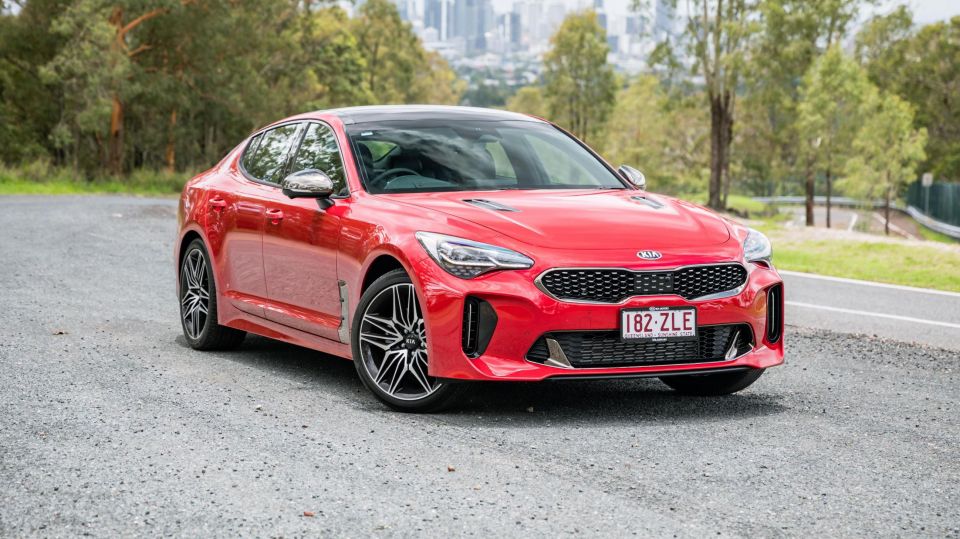
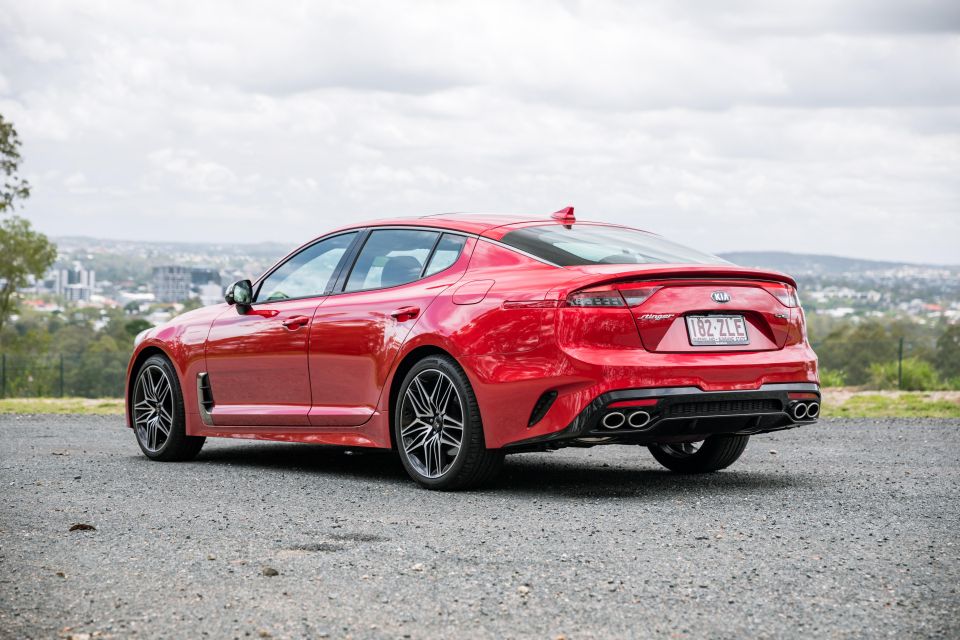

News Editor
New from
$56,290
excl. on-roads

News Editor
New from
$56,290
excl. on-roads


News Editor
New from
$56,290
excl. on-roads

News Editor
New from
$56,290
excl. on-roads
Quickly see how this car stacks up against its competition. Select any benchmark to see more details.
Where expert car reviews meet expert car buying – CarExpert gives you trusted advice, personalised service and real savings on your next new car.
I had to remind myself every time I got behind the wheel of the 2021 Kia Stinger GT-Line that not every Ford Falcon was an XR6 Turbo and not every Holden Commodore was an SS. There’s a place for a less powerful engine, even in a sporty model like this.
And yet, with the Kia Stinger, the more powerful of its two engines is the more popular by a significant margin – the sales mix is somewhere in the realm of 8:1 – due to a smaller range and little in the way of fleet sales, except to police forces.
It’s a similar story to the Ford Mustang, minus the fleet sales part, where the V8 vastly outsells the EcoBoost four-cylinder in Australia.

Kia says there’s growing interest in the Stinger’s two four-cylinder variants and yet, despite that, we’re missing out on the new turbocharged 2.5-litre four-cylinder introduced in Korea and soon to be available in North America. Essentially, even if four-cylinder Stinger sales are up, they’re still too small a piece of the pie to warrant getting the 2.5-litre, which won’t be even be offered in Europe.
Though we haven’t been graced with the new four, Australia has picked up the other global updates including tweaked exterior styling with new tail lights and wheel designs, as well as a larger 10.25-inch touchscreen infotainment system inside and a raft of new safety equipment.
With no new four, the Stinger is left with a carryover turbocharged 2.0-litre four-cylinder engine.
While good on paper when stacked against four-cylinder rivals, it’s nowhere near as powerful as the twin-turbo V6. But is it still worth your money, particularly considering the four-cylinder flagship, the GT-Line, is pricier than the base six?
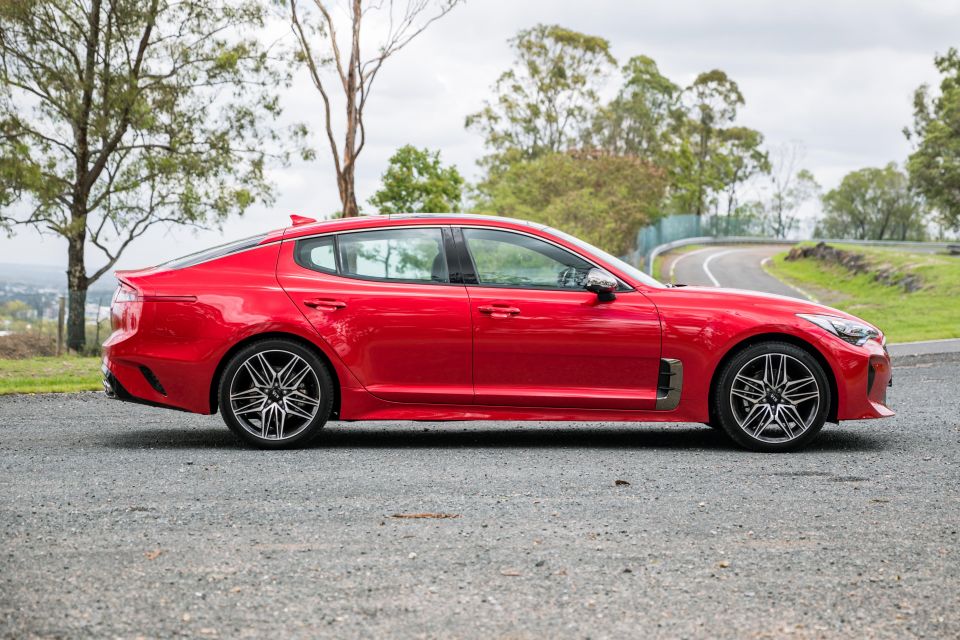
The 2021 Kia Stinger range opens with the 200S at $49,550 before on-road costs, or $53,090 in current drive-away pricing.
If you want more equipment, our GT-Line tester bumps that up to $57,230 before on-roads ($60,690 drive-away) and offers almost all the equipment of the flagship, twin-turbo V6 GT.
If sheer grunt is more important to you, there’s a Stinger between the 200S and GT-Line in price with the GT’s twin-turbo V6. That’s the 330S, priced at $53,330 before on-roads ($56,890 drive-away), which undercuts the GT-Line by a few thousand dollars.
Finally, if you want it all, the GT is priced at $63,260 list ($66,690 drive-away).
As a well-equipped, rear-wheel drive sedan from a mainstream brand, the Stinger GT-Line has essentially no direct competition. Indirectly, however, there’s plenty at this price point.
The Chrysler 300C Luxury is priced at $59,950 before on-roads and offers a similarly long features list, although its focus is more on luxury than on performance. Those after sleek fastback styling like on the Stinger may also be interested in the Peugeot 508 GT ($57,490 list).
In terms of luxury brand competition, the Audi A4 35 TFSI S line slips under the $60,000 barrier at $59,900 list. While its equipment list is shorter than the Stinger’s and its outputs much lower, it does have the allure of the four-ringed badge. You can also save $4000 and drop the S line package.
Arguably though, Audi’s A5 Sportback is conceptually the Stinger’s most direct rival, though the base 40 TFSI S line starts at $71,900 plus on-road costs – much more than the top-spec four-cylinder Stinger.
Other similarly-priced Euros include the Volvo S60 T5 Momentum ($55,990 list) and Mercedes-Benz A250 4Matic sedan ($59,700 list). To get into a BMW 3 Series or Lexus IS, though, you’ll need to cross that $60,000 threshold.
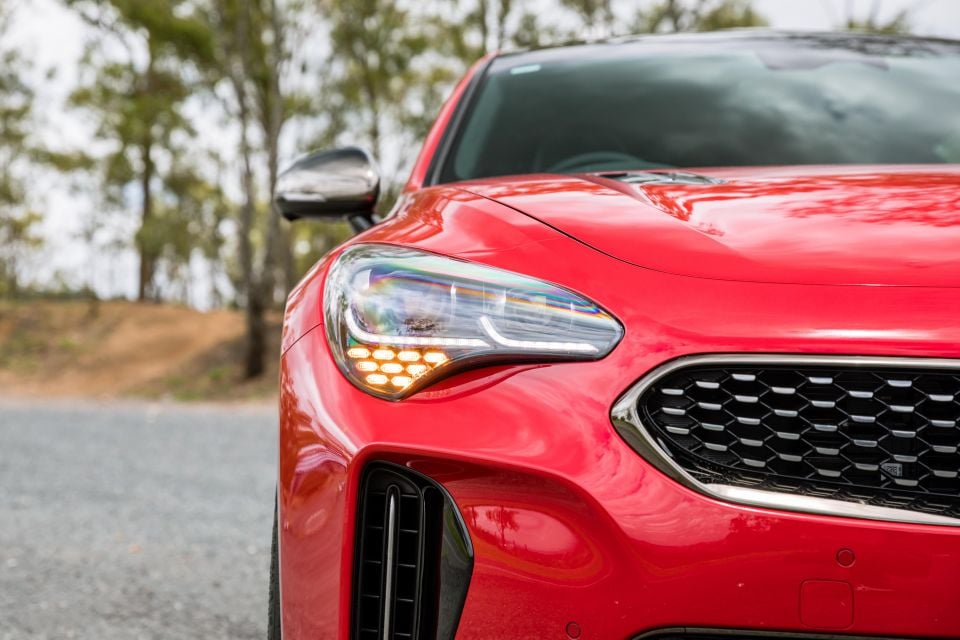
Buy your new car without the stress. It's fast, simple and completely free.

Great service from Travis and team, second time I have used this business would not hesitate to recommend them to anyone
Craig C.
Purchased a Ford Ranger in Sunshine Coast, QLD
CarExpert helped Craig save thousands on his Ford Ranger, now let us save you on your next new car.
Find a dealAs the flagship four-cylinder in the Stinger line, the GT-Line has almost every feature available in a Stinger with only a handful of exceptions.
It misses out on the six-cylinder GT’s Brembo brakes and adaptive dampers, while inside it only uses regular leather upholstery instead of the GT’s Nappa hide. The GT is also unique in offering electronic adjustment for the Stinger’s standard tilt and telescoping steering wheel.
Otherwise, the GT-Line has the whole enchilada including numerous new or enhanced safety features.
The base 200S already comes standard with LED headlights, adaptive cruise control, keyless entry and start, remote start, dual-zone climate control, an eight-way power driver’s seat and a reversing camera with rear parking sensors.
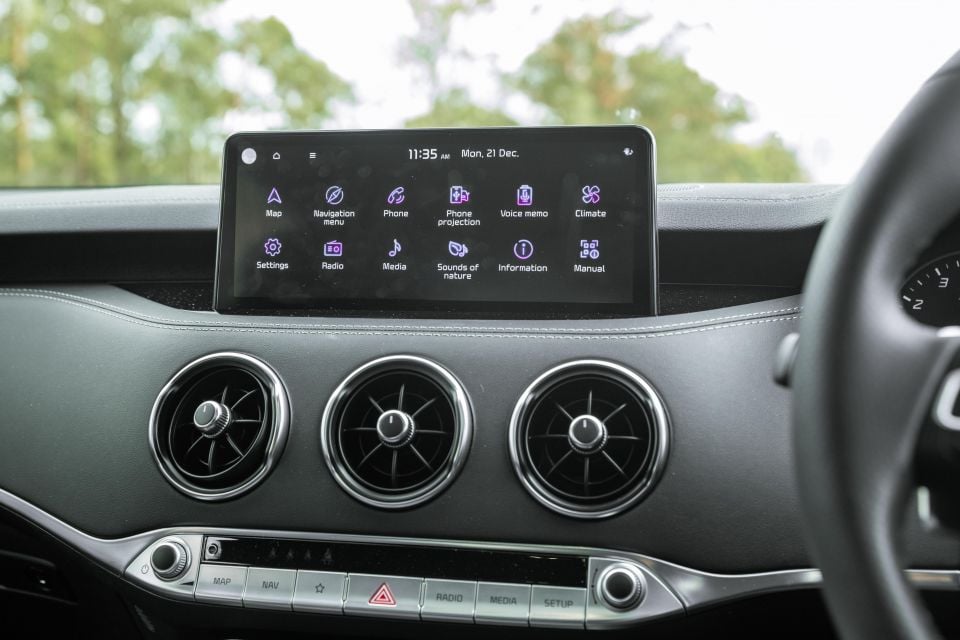
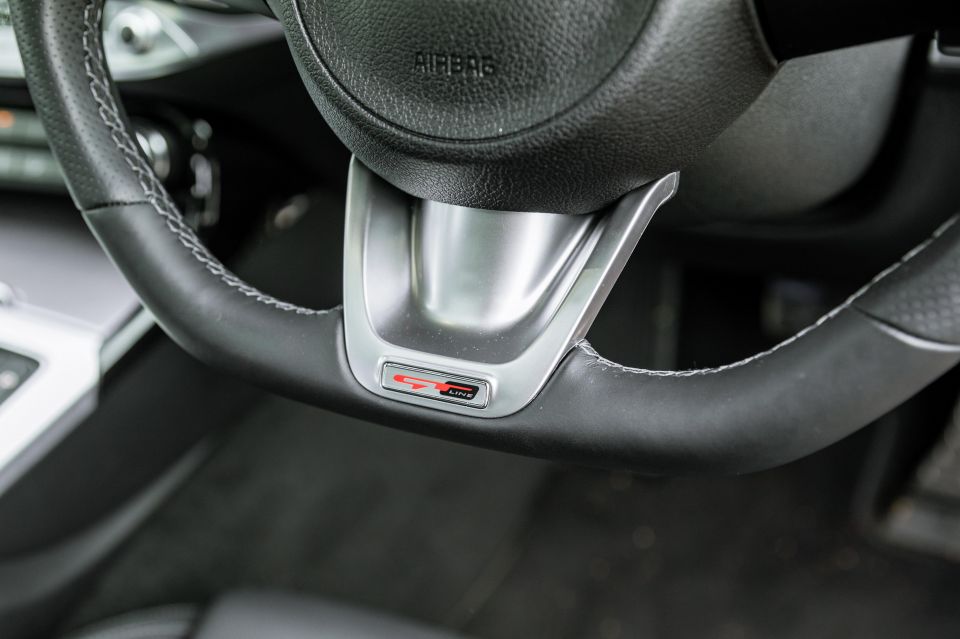
The infotainment system has also been upgraded to a 10.25-inch touchscreen infotainment system with DAB digital radio, satellite navigation, and wired Apple CarPlay and Android Auto. Last year’s model offered a 7.0-inch unit in the 200S and an 8.0-inch in the GT-Line.
The GT-Line adds a surfeit of luxury goodies over the 200S. These include leather upholstery, heated and ventilated front seats, a sunroof, eight-way power passenger’s seat, suede trim for the roof and pillars, a 15-speaker Harman/Kardon sound system, colour-adjustable ambient lighting, and a heated, flat-bottomed and leather-wrapped steering wheel
Additional convenience features include a larger, 7.0-inch display in the instrument cluster, plus automatic high-beam, a head-up display and wireless charging. The GT-Line also gains a mechanical limited-slip differential, active bending lights, a surround-view camera, alloy pedals, and larger 19-inch alloy wheels (instead of 18-inch ones) that look great and remind us of throwing stars.
While the GT-Line costs a substantial $7680 more than the base 200S, that’s more than justified by the extended list of standard equipment. Mind you, if those extras don’t interest you the more powerful 330S is cheaper, though it misses out on some of the GT-Line’s new safety features.

When the Stinger was tested by ANCAP in 2017, it received a rating of five stars. That was based on an adult occupant protection score of 91 per cent, child occupant protection of 81 per cent, pedestrian protection of 78 per cent and safety assist of 70 per cent.
For 2021, the Stinger range’s autonomous emergency braking system adds cyclist detection and junction assist, which will apply the brakes if you attempt to turn into oncoming traffic. The lane-keeping assist system now has road edge detection, while lane-following assist is also new for 2021.
GT-Line and GT models upgrade from blind-spot monitoring and rear cross-traffic alert to blind-spot assist and rear cross-traffic assist, capable of applying the brakes if it detects an imminent collision. Kia has also added a blind-spot camera display in the instrument cluster plus safe exit warning.
In terms of passive safety, there are front, front-side and curtain airbags plus a driver’s knee bag.
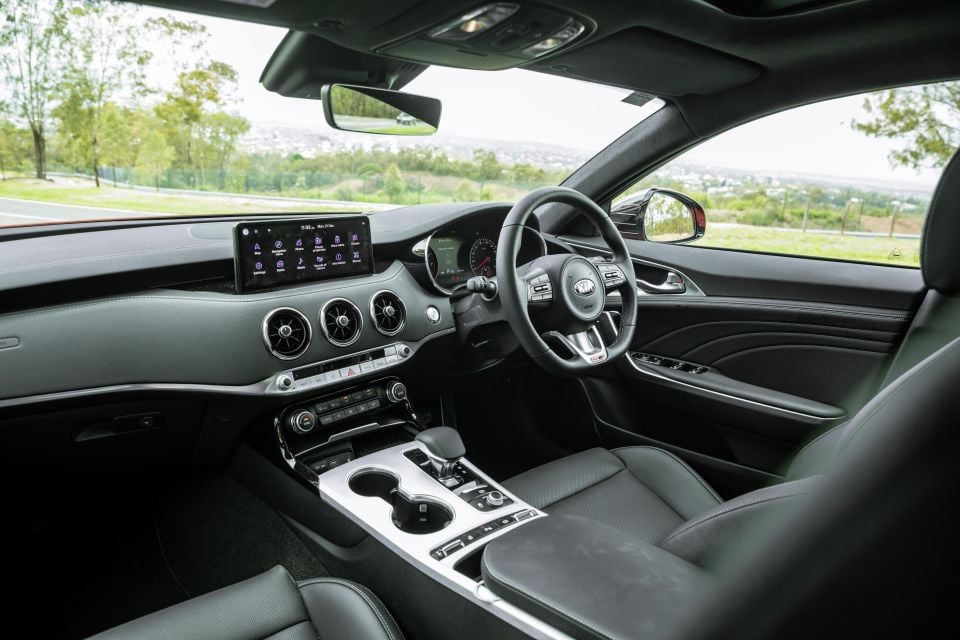
Apart from the considerably larger, 10.25-inch touchscreen, tweaks to the interior are minor. They include a new metallic finish for the steering wheel and new stitching on the dash and doors.
The ledge on which the infotainment screen sits is also now finished in piano black. We usually loathe this material for how quickly it gets dusty and smudged but on a surface you won’t be touching often, but it’s more visually appealing than hard, grey plastic.

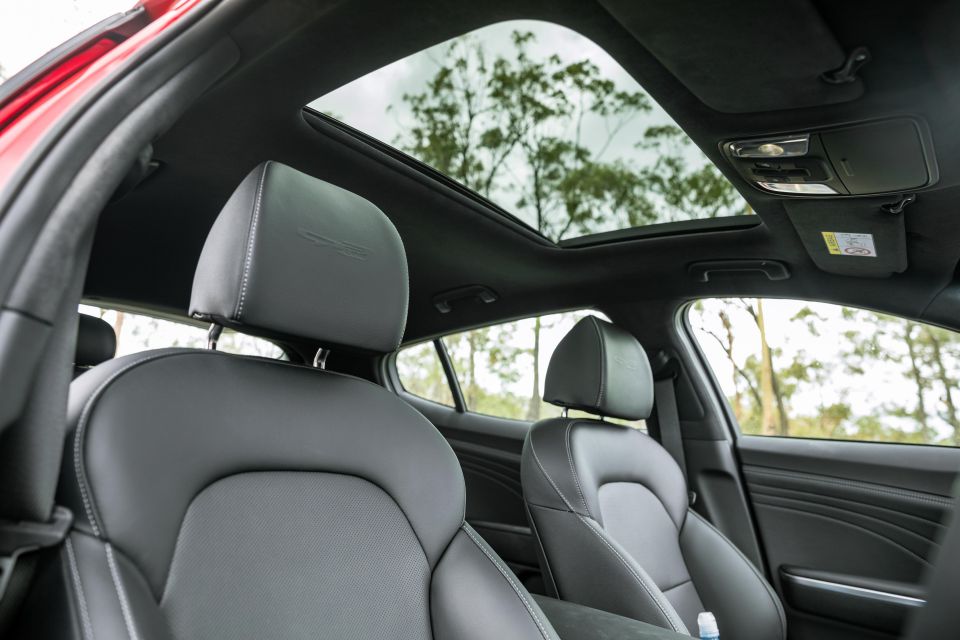
We’d love to see the stuff banished from the sides of the centre console, though, and replaced with leather or soft-touch plastic as the piano black trim is hard on your knees.
The dearth of changes to the interior for 2021 isn’t a big deal. This remains an attractive interior constructed from high-quality materials, with leather-look trim and soft-touch plastics used in most places bar the lowest reaches of the dash and doors.
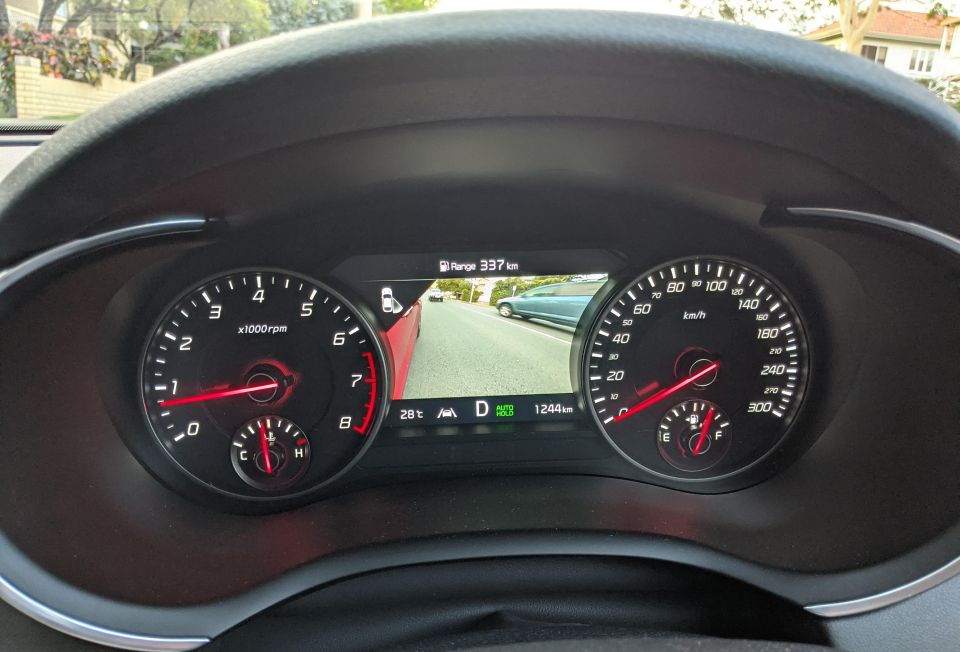
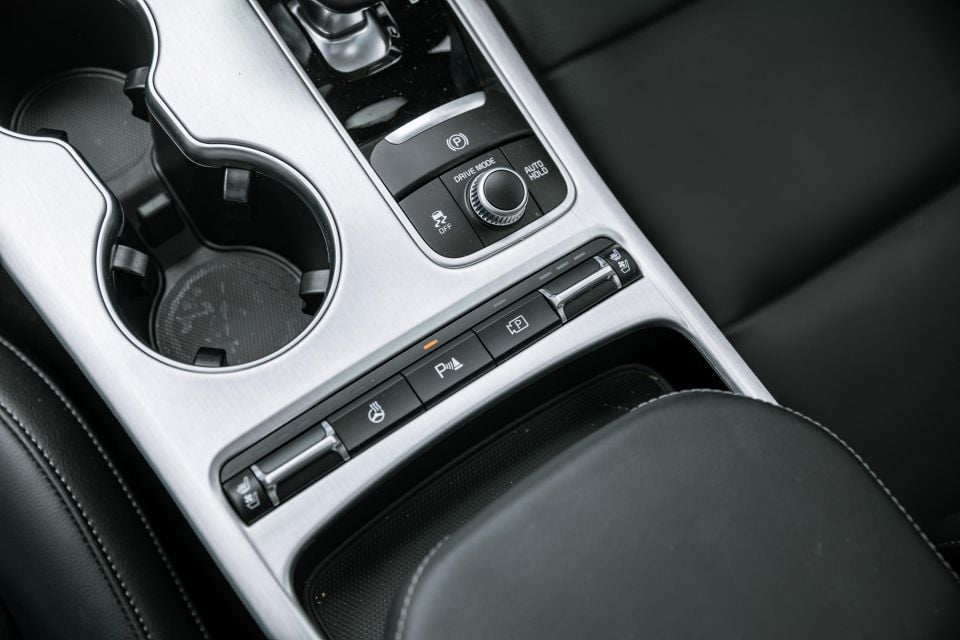
The switchgear is hard to fault, and we particularly like the use of an actual drive mode dial instead of a button as in many other Kias. The neat rocker switches for the heated and ventilated seats also feel solid.
Technology is well integrated in the cabin, too. The head-up display is easy to read and neatly presented, with the speed you’re travelling at changing colour from white to orange and then red based on how far you’re exceeding the speed limit.
While the Stinger doesn’t add an entirely digital instrument cluster like some Hyundai and Kia products, the 7.0-inch screen between the analogue gauges has been upgraded to display footage of your blind spot when you turn on your indicator.
The colour-adjustable ambient lighting is attractive and elevates the interior. I changed it to a nice indigo to match the user interface of the new touchscreen infotainment system, which has a pink, purple and blue colour scheme.
Unlike frumpier user interfaces like those used by Nissan and Toyota, the new Kia interface looks fresh, modern and rather fun. As is typical for a Kia, too, it’s all very easy to navigate and responds quickly to inputs.
It also adds new features seen on other Hyundai Motor Group products, like the Sounds of Nature program that allows you to listen to the sounds of a busy cafe or someone trudging through the snow.
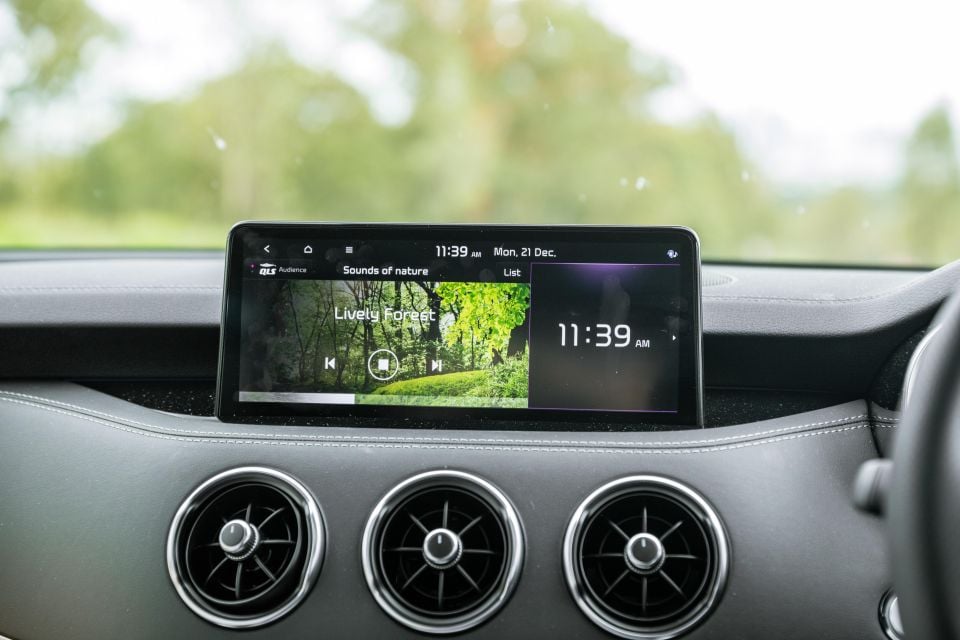
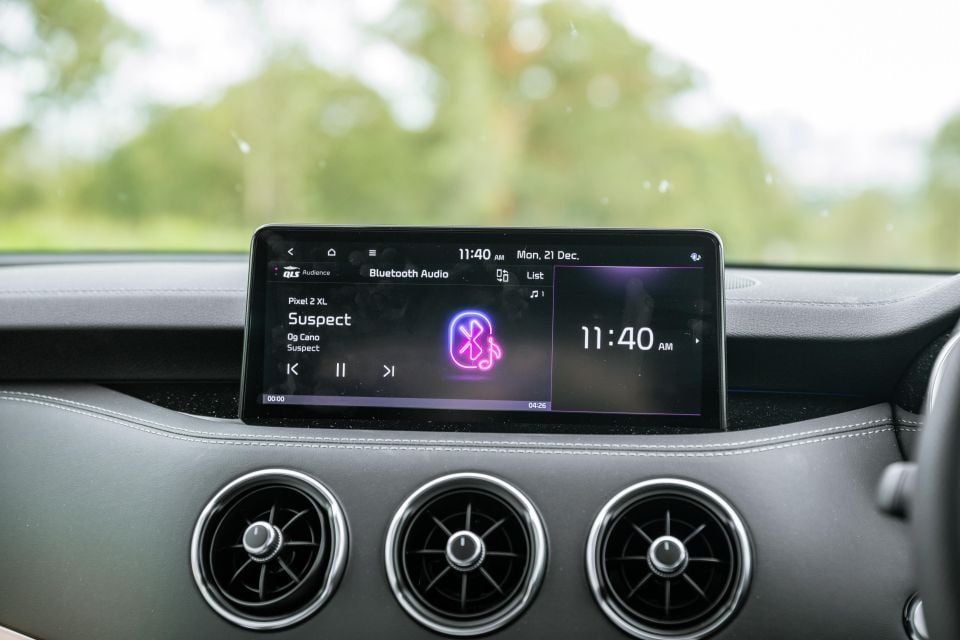
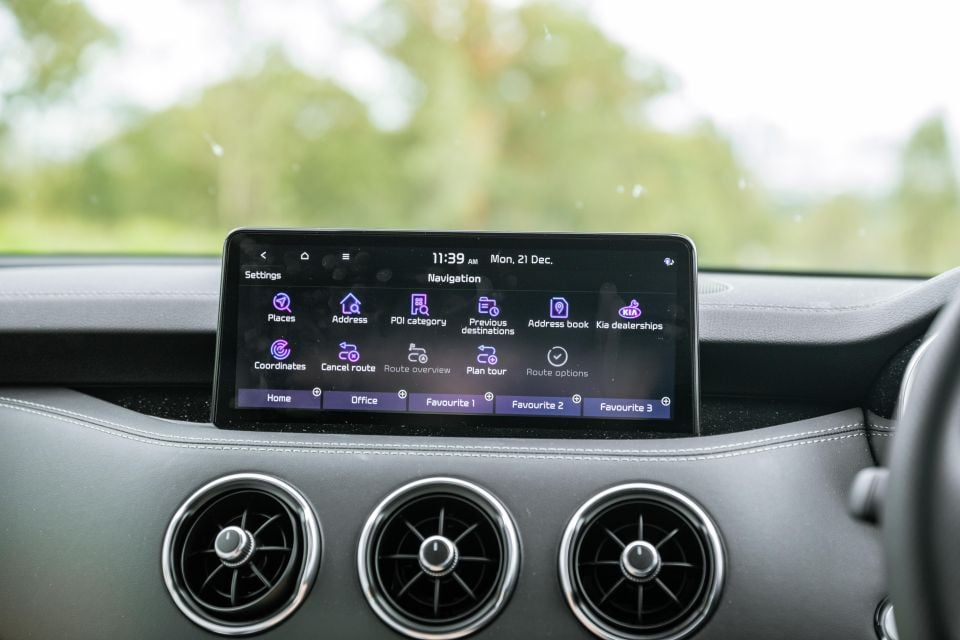
Unfortunately, smartphone mirroring doesn’t take up the whole display so you’re left with one third of the screen taken up by an only moderately useful clock or compass.
While I was able to replace that dead space with a map in a recent Genesis G80 tester, it wasn’t immediately clear whether I could swap out the clock or compass for something more useful in the Stinger.
Storage up front is acceptable if not ground-breaking. The centre console bin is quite large if not overly deep and there’s a small tray ahead of it you could keep your sunglasses in, plus a sunglasses holder on the roof by the sunroof controls.

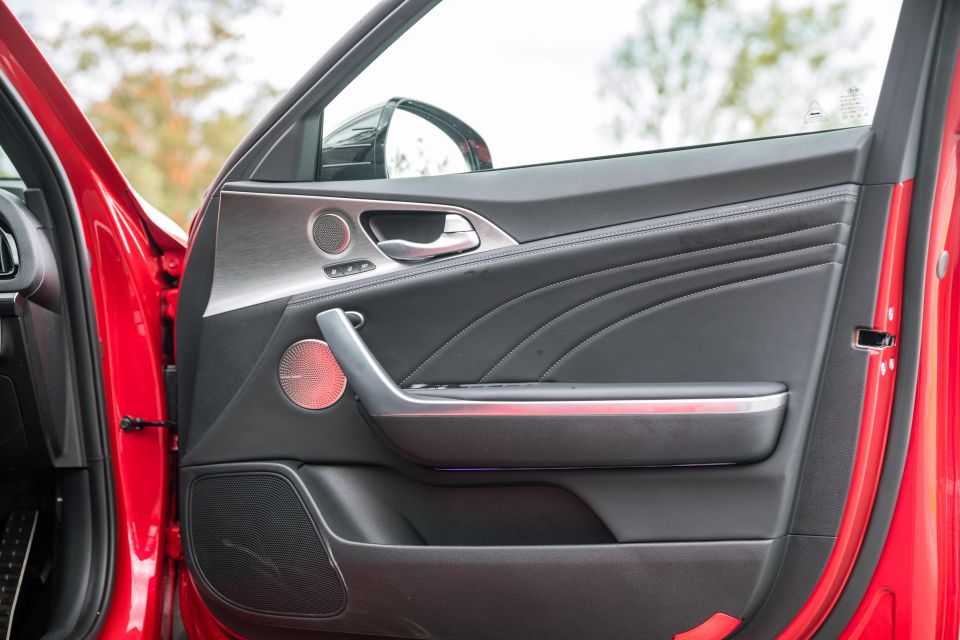
There’s also a concealable shelf at the base of the centre stack that has a wireless charging pad and 12V and USB outlets, though there’s little room for odds and ends and some larger phones may struggle to fit. Finally, the front doors have bottle holders that’ll easily accommodate 600ml bottles.
Despite the sleek roofline, there’s sufficient headroom and legroom for passengers around 180cm tall in the rear.
Those more gifted in the height department may struggle, however, and adults would be wise to duck their head as they step in.

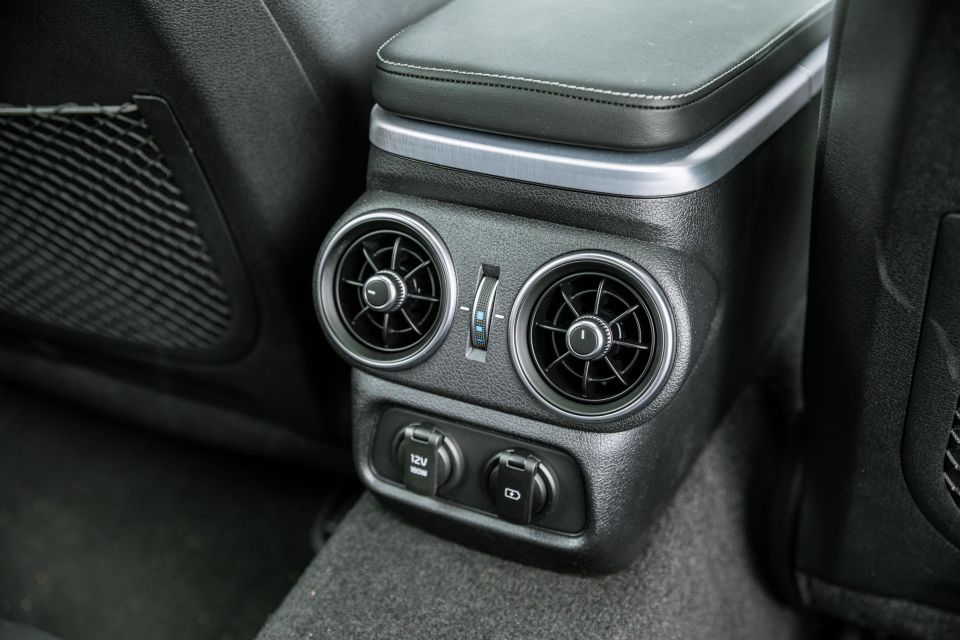
You also won’t want to wedge an adult in the centre seat. The centre tunnel is quite large and the Stinger isn’t quite wide enough to comfortably sit three grown adults abreast.
Rear passengers have a 12V outlet and a USB outlet to use back there and, while the front seatbacks are hard, they’re scooped out to aid knee room and have nets for stowage.
As in the front, the bottle holders in the rear doors can also store a decently-sized bottle, while there are three top-tether and two ISOFIX anchor points for child seats.
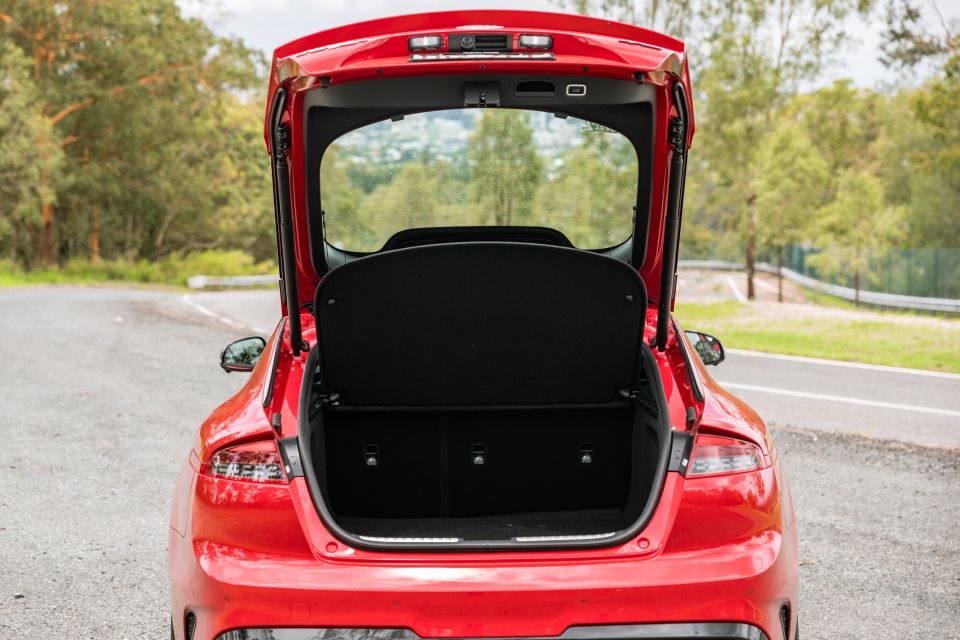
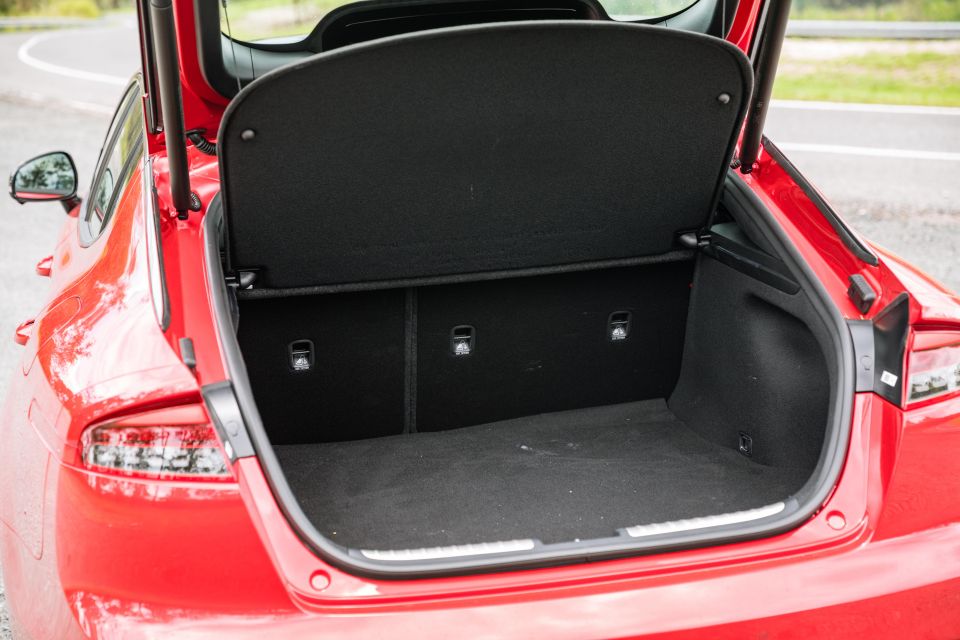
Centre tunnel aside, this is sufficiently spacious for a medium-to-large passenger car.
The ace up its sleeve is the large rear tailgate, allowing you to stow large, bulky items you wouldn’t be able to wedge into a sedan.
Total luggage space is 406L, increasing to 1114L with the rear seats folded. Under the boot floor is a space-saver spare.

Where expert car reviews meet expert car buying – CarExpert gives you trusted advice, personalised service and real savings on your next new car.
Powering the GT-Line is a turbocharged 2.0-litre four-cylinder engine producing 182kW of power and 353Nm of torque. It’s mated to an eight-speed automatic transmission and rear-wheel drive, and Kia claims a 0-100km/h time of 6.0 seconds.
By comparison, the Stinger’s twin-turbo 3.3-litre V6 puts out 274kW and 510Nm and slashes that sprint time to 4.9 seconds.
The new turbocharged 2.5-litre four has outputs closer to the six, with 223kW of power and 421Nm of torque. Alas, it’s off-limits to us.

If we had one complaint about the outgoing six-cylinder Stinger, it’s that it was too quiet. Its hushed engine note was still easy on the ears, however.
The four-cylinder Stinger – while falling short of being unrefined – has an engine note that is uninspiring at best and unpleasant at worst.
Under hard acceleration, the Stinger sounds about as appealing as a 2.0-litre Cerato. While a four-cylinder typically sounds worse than a six or an eight, it’s possible to develop a sonorous four – take, for example, the Alfa Romeo Giulia. Fortunately, Kia has a feature that mitigates this.
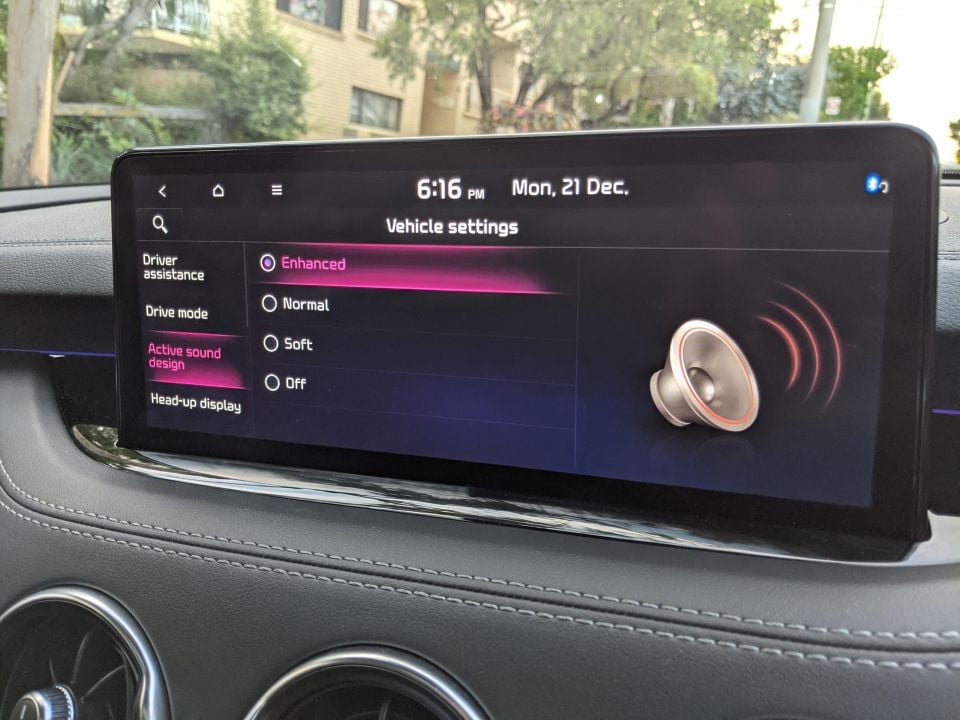
Toggling the Active Sound Design feature pipes a more dynamic sound into the cabin. It doesn’t sound particularly authentic and it’s a bit over-the-top, but it sounds sportier and therefore more befitting of a Stinger.
For 2021, the Stinger GT-Line picks up a mechanical limited-slip differential like in the six-cylinder models but loses its adaptive dampers. That means there’s no longer a way to adjust the ride comfort.
The Stinger GT-Line may not crash over bumps but it has a firm, busy ride that’s especially noticeable in urban driving at lower speeds. Out on the open road, however, it smooths out.

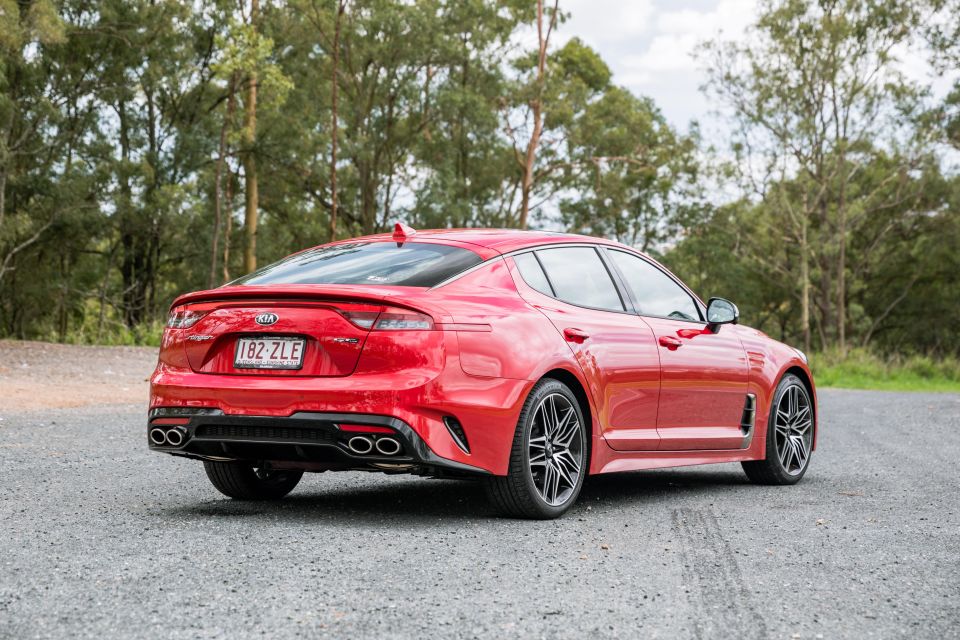
The firm ride does come hand-in-hand with competitive handling. Despite its dimensions, this doesn’t feel like a lumbering, large sedan. Instead, it feels more like a BMW 3 Series-sized rear-wheel drive sedan.
Turn-in is crisp and the steering is well-weighted, though a touch more feel wouldn’t go amiss.
The Stinger feels planted and you can carry a good amount of speed into corners, such is the tied-down nature of the chassis and its lack of body roll.
Though Sport mode no longer adjusts the dampers, it still makes a noticeable difference in throttle response and a slight difference in steering feel. That’s a relief, as there’s a slight delay off the line in Comfort mode which can be annoying.
Flicking the dial to Sport sees the seat bolsters hug you in and the Active Sound Control come into play (note: you can adjust the level of sound). Working in concert with a smooth-shifting eight-speed automatic, the turbocharged 2.0-litre feels sufficiently punchy and the Stinger GT-Line is still an eager back road companion.
Though its engine sound – artificial or authentic – can be a tad boisterous, other noise like that from the tyres or the wind is well contained.
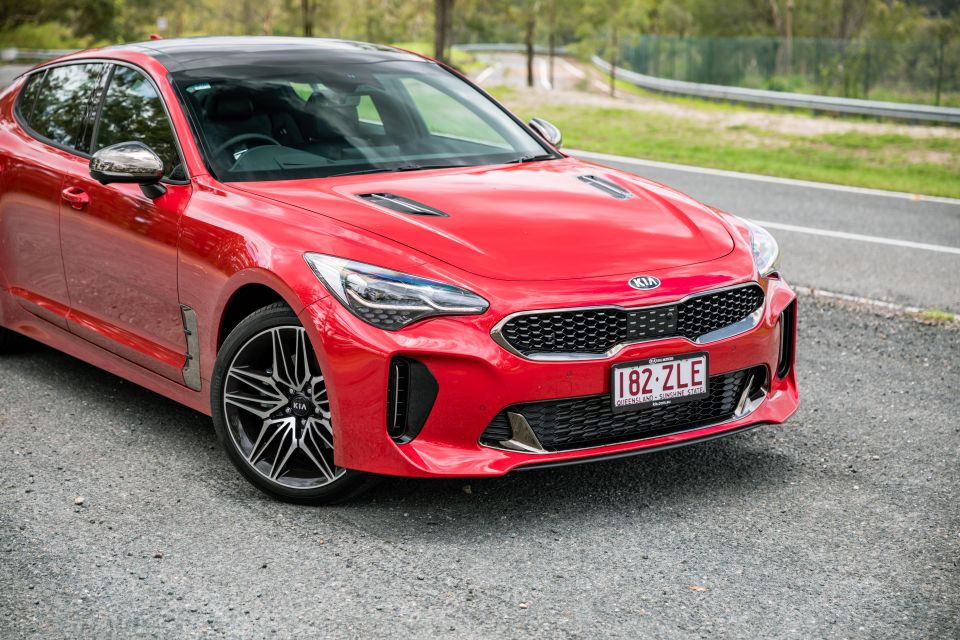
The dynamic bending LED headlights are terrific, with the beam of the lights moving with the steering wheel. This is useful technology that’s strangely missing from some of Hyundai Motor Group’s more expensive fare like the new Genesis G80.
While we (thankfully?) weren’t able to test some of the 2021 Stinger’s new safety features like blind-spot assist and rear cross-traffic assist, we were able to test the upgraded lane-keeping assist. It was hard not to – it defaults to on when you start the car.
The lane-keeping assist is a bit aggressive at keeping you in your lane but at least it’s consistent, though its firm tugging at the wheel is too intrusive in some settings – I deactivated it for back road jaunts, for example.
The lane-following assist works eerily well and, though it prompts you quite quickly to keep your hands on the wheel, you get the feeling it could easily drive you quite a distance – particularly on the highway – without your intervention.

Driving around the city in Comfort mode, the Stinger GT-Line disappointed – a coarse engine and a firm ride, but without the twin-turbo thrust of the six-cylinder.
Fortunately, putting it in Sport mode and venturing out to a more enjoyable driving road revealed even the four-cylinder Stinger can put a smile on your face.
Nevertheless, if you’ve driven the twin-turbo V6 Stinger, the four-cylinder is clearly an inferior substitute. While the difference on paper mightn’t seem large, the V6 feels much quicker.
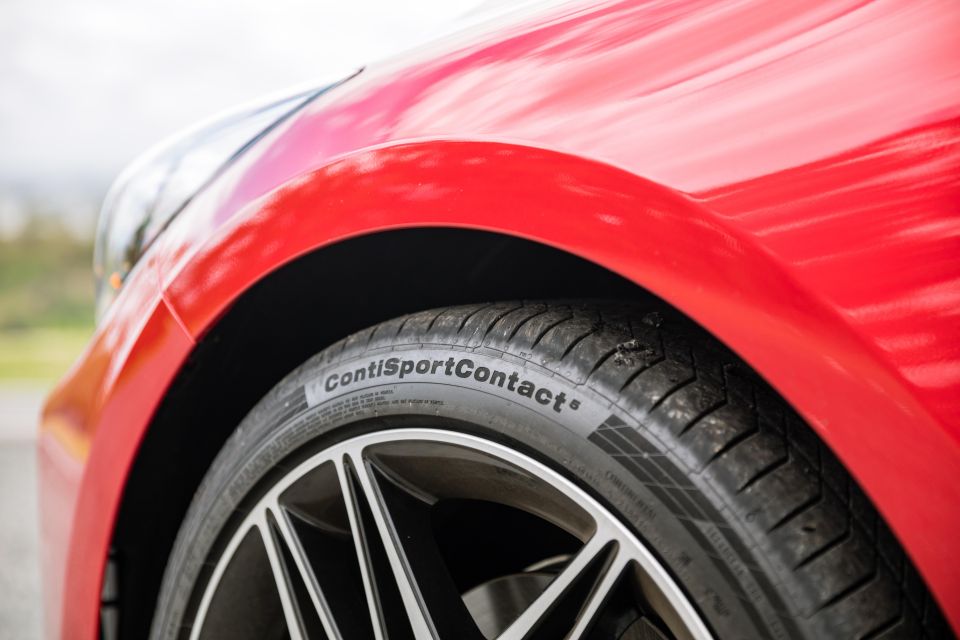
We averaged 10.1L/100km on our test loop, a mix of highways and inner-city and suburban roads. Over a week of driving, we observed fuel consumption of 10.7L/100km.
Kia claims a combined fuel economy of 8.8L/100km for the four and 10.2L/100km for the six. Both engines require only 91RON regular unleaded fuel.
The company offers seven years of capped-price servicing in addition to its seven-year, unlimited-kilometre warranty. The first seven visits cost $312, $498, $399, $685, $351, $635 and $669, or an average of $507 a service.
That undercuts the six, which has an average service price of $606. Both models require servicing every 12 months or 10,000km, whichever comes first.
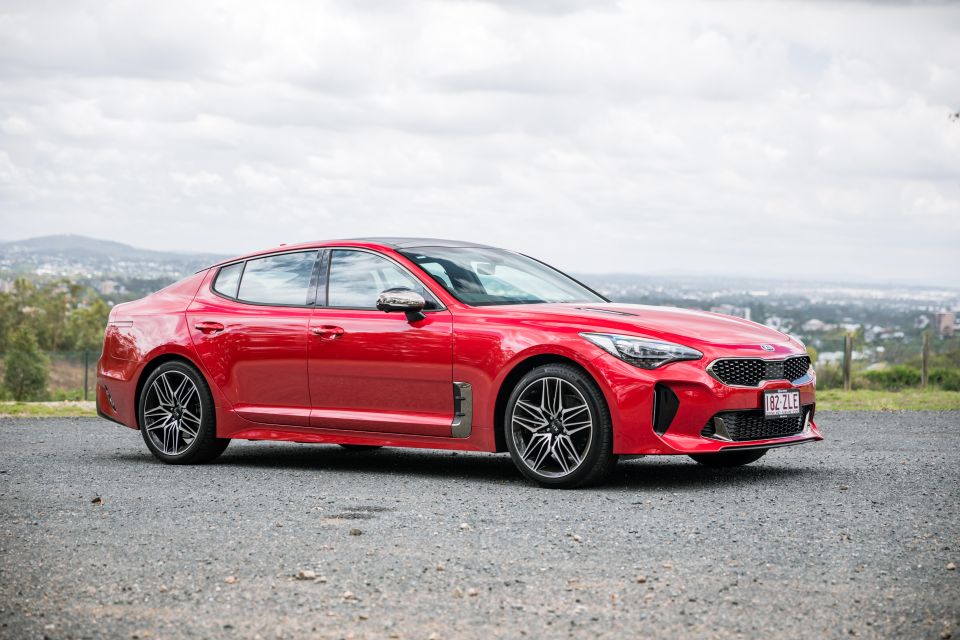
The Stinger GT-Line continues to offer a lot of metal for the money, plus an equipment list nothing at this price point can compete with. And if you’ve never driven a twin-turbo V6 Stinger, you might just be satisfied with the four-cylinder GT-Line.
The Stinger GT-Line looks great and handles well, while its hatchback body style provides plenty of versatility. But its firm ride suggests a level of sportiness its uninspiring engine can’t deliver.
While they can’t offer the fluid dynamics of the Stinger’s rear-wheel drive platform, if all you want is a well-equipped mid-sized sedan or hatchback, you can buy a Toyota Camry SL V6 for $45,290 before on-roads, a turbocharged Mazda 6 Atenza for $49,890 list or the updated, richly-equipped Volkswagen Passat 162TSI Elegance for $51,790 list.
This is a car that really comes alive with the twin-turbo V6, where it represents an astonishing performance bargain. Remove that engine, however, and the Stinger’s value proposition diminishes, even with an equipment list a mile long.
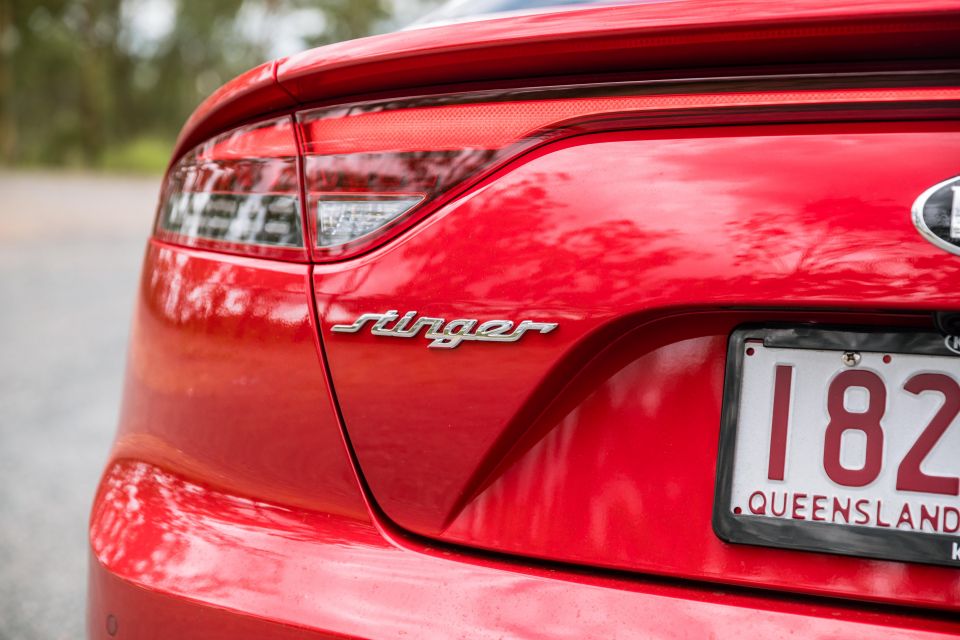
Click the images for the full gallery
MORE: Kia Stinger news and reviews MORE: Everything Kia
Where expert car reviews meet expert car buying – CarExpert gives you trusted advice, personalised service and real savings on your next new car.
William Stopford is an automotive journalist with a passion for mainstream cars, automotive history and overseas auto markets.


Max Davies
5 Hours Ago


William Stopford
21 Hours Ago


Ben Zachariah
22 Hours Ago


Derek Fung
23 Hours Ago


Matt Campbell
1 Day Ago


William Stopford
2 Days Ago